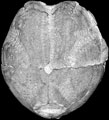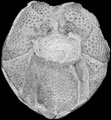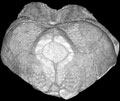The Echinoid Directory
Contributed by Pedro Pereira, November 2012
Echinocardium olisiponensis Kotchetoff, Kotchetoff & Ferreira, 1975
| Diagnostic Features |
|
|---|---|
| Distribution | Middle Miocene of Portugal. |
| Type | Holotype, Museu Geologico (Lisbon, Portugal) MG 3795a; syntypes MG 3611, 3614a-c 3630, 3789-91 and 3795b. |
| Classification and/or Status | A species of Echinocardium. |
| Remarks | Only two living species present an inner fasciole that extends about two-thirds of test length and have its paired petals greatly expanded adapically so that the pore zones Ib and IIa, respectively IVb and Va, form lateral arcs: E. cordatum and E. mediterraneum. E. cordatum differs from E. olisiponensis by its different organization of pores in the adapical part of ambulacrum III (offset into two irregular rows in E. cordatum and uniserial in E. olisiponensis), smaller area circumscribed by subanal fasciole and the number (four) of ambulacral plates extending into it, its narrower periproct, and its anal fasciole extending adapically from subanal fasciole. E. mediterraneum differs by the different pattern of its inner fasciole (maximum width immediately ahead of anterior poriferous zones of anterior paired petals), its well developed subanal heel, its narrower periproct, the smaller area circumscribed by its subanal fasciole and the number (four) of ambulacral plates extending into it and its anal fasciole extending adapically from subanal fasciole. E. orthonotum differs from E. olisiponensis by its more anteriorly displaced apical disc, shallower anterior ambulacrum, distinctly less inflated interambulacra, presence of four to five large pore-pairs within inner fasciole in posterior poriferous zones, three ambulacral plates extending into the subanal fasciole, anal fasciole extending adapically from subanal fasciole. E. marylandiense differs by its relatively wider and higher test, more anteriorly displaced apical disc, presence of three to five large pore-pairs within inner fasciole in posterior poriferous zones, less anteriorly displaced peristome, narrower periproct, presence of an anal fasciole. Kotchetoff, B; Kotchetoff, Y. & Ferreira, O. V. 1975. Contribution a la connaissance des gisement fossiliferes miocenes au Nord du Cap d'Espichel. Comunicaces dos Servicos Geologicos de Portugal, Lisboa, 59, 59-106, 8 pls. Pereira, P. 2010. Echinoidea from the Neogene of Portugal mainland. Palaeontos, Mortsel, 18, 154 pp, 37 pls. |




